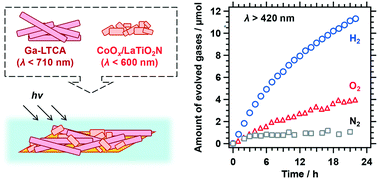当前位置:
X-MOL 学术
›
Catal. Sci. Technol.
›
论文详情
Our official English website, www.x-mol.net, welcomes your
feedback! (Note: you will need to create a separate account there.)
Particulate photocatalyst sheets based on non-oxide semiconductor materials for water splitting under visible light irradiation†
Catalysis Science & Technology ( IF 4.4 ) Pub Date : 2018-07-06 00:00:00 , DOI: 10.1039/c8cy00860d Takashi Hisatomi 1, 2, 3, 4, 5 , Takahiro Yamamoto 1, 2, 3, 4, 5 , Qian Wang 1, 2, 3, 4, 5 , Takahiro Nakanishi 1, 2, 3, 4, 5 , Tomohiro Higashi 1, 2, 3, 4, 5 , Masao Katayama 1, 2, 3, 4, 5 , Tsutomu Minegishi 1, 2, 3, 4, 5 , Kazunari Domen 1, 2, 3, 4, 5
Catalysis Science & Technology ( IF 4.4 ) Pub Date : 2018-07-06 00:00:00 , DOI: 10.1039/c8cy00860d Takashi Hisatomi 1, 2, 3, 4, 5 , Takahiro Yamamoto 1, 2, 3, 4, 5 , Qian Wang 1, 2, 3, 4, 5 , Takahiro Nakanishi 1, 2, 3, 4, 5 , Tomohiro Higashi 1, 2, 3, 4, 5 , Masao Katayama 1, 2, 3, 4, 5 , Tsutomu Minegishi 1, 2, 3, 4, 5 , Kazunari Domen 1, 2, 3, 4, 5
Affiliation

|
Particulate photocatalyst sheets based on a hydrogen evolution photocatalyst (HEP) and an oxygen evolution photocatalyst (OEP) embedded in a conductive material can realize efficient and scalable water splitting. However, existing sheet systems involve photocatalytic materials with absorption edge wavelengths (λabs) of approximately 500 nm. Thus, the development of sheet systems based solely on photocatalysts with longer absorption edge wavelengths is essential for obtaining solar-to-hydrogen energy conversion efficiency required for practical applications. In this study, we present a photocatalyst sheet system based on Ga-doped La5Ti2Cu0.9Ag0.1S5O7 (Ga-LTCA, λabs = 710 nm) as the HEP and LaTiO2N (λabs = 600 nm) loaded with cobalt oxide (CoOx) as the OEP, both embedded in a Au layer by particle transfer (Ga-LTCA/Au/LaTiO2N). Ga-LTCA/Au/LaTiO2N sheets modified with Rh species evolved hydrogen and oxygen simultaneously under visible light irradiation (λ > 420 nm). The loading of CoOx onto LaTiO2N was found to be essential for successful water splitting, as was the choice of pH values during water splitting. The roles of CoOx and other factors in determining the water splitting activity of the Ga-LTCA/Au/LaTiO2N sheets are described herein, based on the photoelectrochemical properties of LaTiO2N photoanodes.
中文翻译:

基于非氧化物半导体材料的颗粒状光催化剂片,用于可见光照射下的水分解†
基于嵌入在导电材料中的析氢光催化剂(HEP)和析氧光催化剂(OEP)的颗粒状光催化剂片可以实现高效且可扩展的水分解。然而,现有的片材的系统涉及用吸收边缘的波长(光催化材料λ ABS的约500纳米)。因此,开发仅基于具有更长吸收边缘波长的光催化剂的片材系统对于获得实际应用所需的太阳能到氢能的转换效率至关重要。在这项研究中,我们提出了一种基于Ga掺杂的La 5 Ti 2 Cu 0.9 Ag 0.1 S 5 O 7的光催化剂片体系。(GA-LTCA,λ ABS = 710纳米)作为HEP和LaTiO 2 N(λ ABS = 600纳米)装载有氧化钴(CoO的X)作为OEP,两者均由颗粒转移嵌入在Au层(GA-LTCA / Au / LaTiO 2 N)。用Rh物种修饰的Ga-LTCA / Au / LaTiO 2 N片在可见光照射下(λ > 420 nm)同时放出氢和氧。发现将CoO x负载到LaTiO 2 N上对于成功的水分解至关重要,在水分解过程中选择pH值也是必不可少的。CoO x的作用本文基于LaTiO 2 N光阳极的光电化学性质,描述了确定Ga-LTCA / Au / LaTiO 2 N片的水分解活性的其他因素。
更新日期:2018-07-06
中文翻译:

基于非氧化物半导体材料的颗粒状光催化剂片,用于可见光照射下的水分解†
基于嵌入在导电材料中的析氢光催化剂(HEP)和析氧光催化剂(OEP)的颗粒状光催化剂片可以实现高效且可扩展的水分解。然而,现有的片材的系统涉及用吸收边缘的波长(光催化材料λ ABS的约500纳米)。因此,开发仅基于具有更长吸收边缘波长的光催化剂的片材系统对于获得实际应用所需的太阳能到氢能的转换效率至关重要。在这项研究中,我们提出了一种基于Ga掺杂的La 5 Ti 2 Cu 0.9 Ag 0.1 S 5 O 7的光催化剂片体系。(GA-LTCA,λ ABS = 710纳米)作为HEP和LaTiO 2 N(λ ABS = 600纳米)装载有氧化钴(CoO的X)作为OEP,两者均由颗粒转移嵌入在Au层(GA-LTCA / Au / LaTiO 2 N)。用Rh物种修饰的Ga-LTCA / Au / LaTiO 2 N片在可见光照射下(λ > 420 nm)同时放出氢和氧。发现将CoO x负载到LaTiO 2 N上对于成功的水分解至关重要,在水分解过程中选择pH值也是必不可少的。CoO x的作用本文基于LaTiO 2 N光阳极的光电化学性质,描述了确定Ga-LTCA / Au / LaTiO 2 N片的水分解活性的其他因素。











































 京公网安备 11010802027423号
京公网安备 11010802027423号